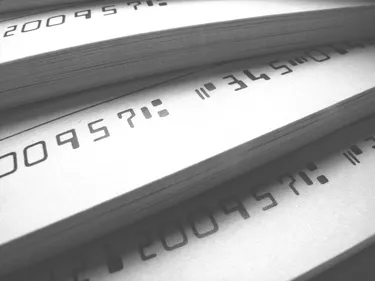
For years, paper checks were manually sorted, grouped and sent back to the banks responsible for paying the transactions. To speed up the check payment process, the American Bankers Association proposed assigning a unique number to each bank. As a result, in 1911 every bank was assigned an ABA routing number. The number is required to process paper checks, automated clearinghouse transactions and wire transfers in the United States, while a different type of number is used for international money transfer services.
Basics of Wire Routing
Video of the Day
One of the fastest and safest ways to send money between banks is via a wire transfer. This is an electronic transfer of funds that's processed between two banks without being sent through the Federal Reserve Bank's automated clearinghouse. The sending bank verifies the account holder's identify and that the account has sufficient funds, while the recipient bank verifies the identify of the recipient account holder. Funds often are available to the recipient the same day they are transferred.
Video of the Day
Importance of an ABA Routing Number
Since the purpose of the ABA routing number is to speed up transactions by getting documentation to the paying bank as quickly as possible, a bank can have up to five routing numbers to assign to different types of transactions, depending on where they are processed. In practice, many banks have even more because of mergers with other banks. Because wire transfers usually are processed separately from other transactions, many banks use a separate ABA Routing Number for these transactions.
ABA Routing Number Design
A wire transfer number is a nine-digit code. The first four digits are assigned by the Federal Reserve Bank. They indicate the Federal Reserve district with jurisdiction for the transaction and contain legacy information about where checks for that district were processed. The next four digits are the bank's ABA identification number within the Federal Reserve district, while the last number is a check digit that helps identify invalid routing numbers that might have been mistyped or misread.
ABA Routing Number Registrar
Since 1911, Acuity has been the official registrar of ABA Routing Numbers. Twice a year, the company publishes the ABA Key to Routing Numbers, which contains the official list of valid ABA Routing Numbers in use at the time. As of 2021, the ABA reported there were approximately 28,000 active ABA routing numbers.
Finding a Wire Routing Number
Whether you're filling out a form to set up direct deposits for a check or other type of income or you want to set up one-time or recurring withdrawals from your bank account, you'll need to know your bank's ABA routing number plus your account number. It's possible that your financial institution may use an ABA number that is only for wire transfers. You can check with the bank or online to determine this and find out what it is.
To find both pieces of information, you'll find it easiest to have a paper check handy. Your wire routing number will be the first set of numbers along the check's bottom, while your account number is the second set of numbers. The third will be the check's number.
If you're out of checks or just don't have one with you, try to log in to your online banking portal. You might find the account and routing numbers where the account is listed on the site, or you may see some link for account information that will display it. You can also check your bank statement for the account number and do a web search for the routing number.